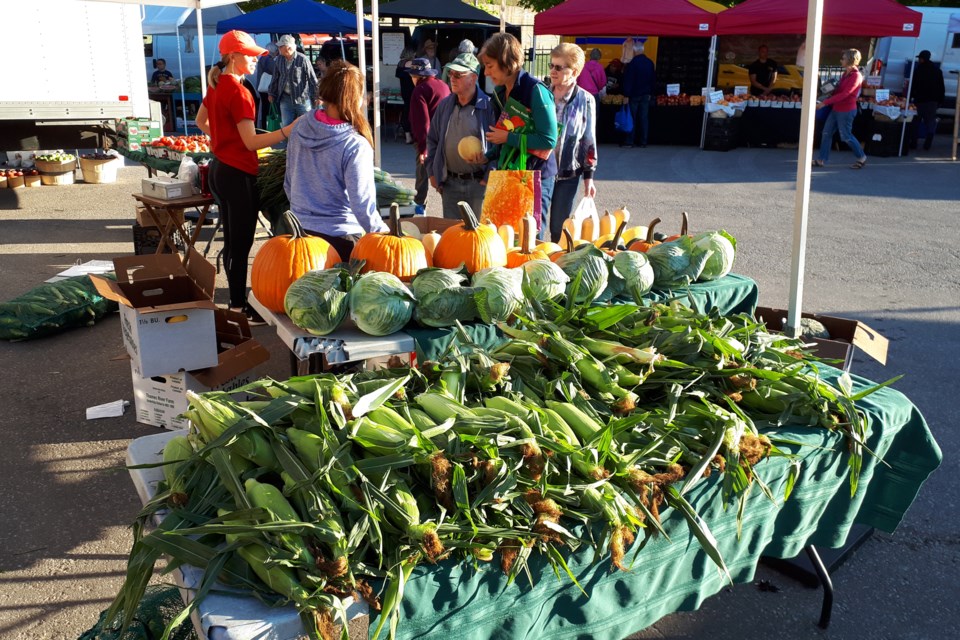It’s sweet corn and fall harvest season.
And there's no shortage, thanks to a combination of favourable weather conditions this summer, including rain and heat in southwestern Ontario.
However, Wellington County did experience a drought in early June, followed by excessive rainfall, which initially led to crop stress and some variability in soil structure.
“Mother Nature can be great for growing plants. But she can also be your foe on the same day,” said Janet Harrop, president of the Wellington Federation of Agriculture.
“In the early spring right after planting, we had a period of dry weather and there was concern around germination. But there was enough residual moisture in the ground, so germination was good.”
The benefits of a little dryness, Harrop says, is that when plants start to grow, they establish deeper roots, find moisture, and adapt quickly, developing a more robust root system,” she said.
The top three crops grown in Wellington County are corn, wheat, and soybeans.
And this year, the right amounts of rain, sunshine and heat has helped corn stalks particularly, to grow faster than in other years.
“Corn is looking really good, and so too are soybeans. When the rain did come in this area, we also saw ‘bumper’ yields for hay,” Harrop said.
But despite this, Harrop says excessive moisture often comes with a few challenges.
“Plants love the wet and really warm humid weather for growing, but everything else also loves that, so you tend to get fungus or different insects,” Harrop said.
“Overall, the genetics of our plants have become quite tolerant to this, so it’s really about keeping a close eye on the plants. You need moisture when the plants are germinating, and then you need moisture when the seed is filling. In between, you need heat.”
A challenge for producers this year, due to wet weather conditions, is making bales of straw and dry hay.
“You need a stretch of about three to four days of dry weather to be able to dry it, bale it, and get it into storage. This has been a big struggle this year,” Harrop said.
“There’s a lot of hay that just can't get dry. So, you will see bales in fields with white plastic around them because of that.”
This, however, creates an extra cost for producers.
“We would often get a day or two, almost dry enough, and then it would rain again,” Harrop said.
“And when it does get rained on, hay must be spread out and dried. It takes so much time and fuel and that too, is so expensive right now.”
These types of challenges can also have impacts on mental health and wellbeing.
“This is because you think you are able to get it done, and then the weather does not cooperate,” Harrop said.
This year, Canadian wildfires have caused poor air quality across the country.
“In Wellington County, we did have a few days that were quite hazy, and you could see the smoke in this area. That does affect the sunlight getting to the plants,” Harrop said.
“But compared to the rest of Canada, we have been pretty fortunate in southern Ontario.”
Harrop says a huge advancement in seed genetics has been a very helpful tool.
“We have seen an improvement in this area when it comes to tolerance to extreme heat, drought, different insect conditions, mould and fungus,” she said.
Wellington County not only has a large percentage of agricultural land, but very fertile soil.
“Because of this, producers are taking more care of the health of soil,” Harrop said.
“By having healthy soil, when roots deteriorate, it leaves organic matter for bugs in the soil. And when the bugs eat that, it leaves holes in the soil that allows for oxygen and water to naturally go down and through that soil.”
Healthy soil increases resilience.
“So, when we have extreme rain, the soil can absorb that rain. When we have periods of drought, the moisture is still in the soil and helps support growing crops,” Harrop said.
“Producers recognize that in growing different crops, one crop will naturally leave more nitrogen in the soil, and another will leave more phosphorous.”
By having a crop rotation that benefits each of those, Harrop says you take advantage of the natural soil conditions.
“And when livestock nutrients are applied to soil, it provides organic matter and pretty much all of the nutrients that the soil and crops need to grow, meaning we rely on virtually no commercial fertilizer,” Harrop said.
Based in Guelph, The Ontario Federation of Agriculture (OFA) is the largest general farm organization in Ontario, advocating for 38,000 farm families across the province working to represent and champion the interests of Ontario farmers.
It's difficult to predict what next summer will bring, but Harrop says research recognizes that farmers growing plants are actually a benefit and a solution to climate change.
“When we talk about sequestering carbon out of the atmosphere, and reducing green house gases, the places most suited to do that are where you see green growing plants," Harrop said.
"And who has the greenest growing plants in the county? It’s farmers.”



